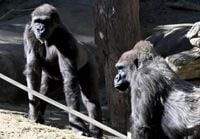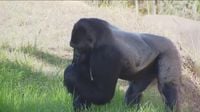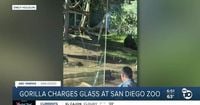Visitors to the San Diego Zoo on Saturday, October 11, 2025, found themselves at the center of an unexpected and dramatic event when Denny, a 10-year-old western lowland gorilla, charged at the viewing glass of his enclosure and shattered one of its protective layers. The incident, which unfolded in the zoo’s gorilla forest habitat, left onlookers startled and, for a moment, unsure of what exactly had happened. But amid the chaos and confusion, one thing was clear: both Denny and the other gorilla sharing the enclosure were unharmed, and no guests or staff suffered any injuries.
According to statements from zoo officials cited by multiple local outlets, including Patch and KGTV, the glass panel that Denny struck is part of a specially engineered, three-layered tempered glass system designed to withstand the immense strength and speed of large male gorillas. Only one layer was compromised in the incident, leaving the other two layers intact and ensuring the safety of everyone present.
Eyewitness accounts captured the shock of the moment. Jackie Doubler, who was at the zoo with his family and girlfriend, likened the impact to an earthquake. “It literally felt like an earthquake... before we realized that that was just him hitting [the glass],” Doubler told KGTV. He described the scene as “pretty scary,” but praised the zoo’s staff and security guards for their quick and effective response. “There definitely were people there quick though, security guards,” Doubler said, adding that the zoo “handled the situation well.”
Another visitor, Katya Sutil, was celebrating her birthday at the zoo when Denny’s charge took her by surprise. She recounted to Fox 5 San Diego, “We were looking down at our cell phones and didn’t notice that he had taken a running start, jumped and launched into the glass. He hit it with his elbow or forearm, like right in the glass directly in front of my face.” The force of the impact was enough to jolt Sutil backwards several feet. “When I looked up to see what had happened, I saw the gorilla staring directly at me, making eye contact with me, and then a giant crack… 6 feet. It was pretty big.”
Video footage shared on social media and reported by CBS8.com showed the dramatic moment as guests stood watching along the glass walls. The crowd’s reactions ranged from alarm to fascination, with some people quickly leaving the area and others rushing closer to see what had happened. As Doubler observed, “If he would hit that glass again, I definitely feel like it would have been a whole different story though.”
In the immediate aftermath, zoo officials made the decision to move both Denny and his companion behind the scenes, away from public view, until the damaged glass panel could be replaced. The San Diego Zoo did not specify when repairs would be completed or whether a different type of glass would be installed. For now, the gorilla enclosure remains closed to visitors, with no timeline yet provided for its reopening.
While the sight of a gorilla charging the glass can be alarming, animal behavior experts caution against jumping to conclusions about aggression. Dr. Annie Petersen, an animal behavior and bonding specialist, told KGTV that such actions can be triggered by a variety of external stimuli. “It may not necessarily have been an aggressive reaction; it may have been one of excitement, it may have been one of exploration,” Petersen explained. Indeed, Sutil noted that during her visit, “the gorillas were going back and forth, kind of taunting each other. One would charge the other and then disappear, then it would happen again. So maybe there was tension going on between the two gorillas.”
Western lowland gorillas, the species to which Denny belongs, are critically endangered and native to the forests of Central Africa. Their numbers have been decimated by habitat loss due to logging and mining, as well as by hunting. The San Diego Zoo is actively involved in conservation efforts aimed at protecting these remarkable primates and their natural habitats. According to Patch and KSWB/KUSI, the zoo’s commitment to gorilla conservation remains a central part of its mission, and incidents like Saturday’s serve as a reminder of the powerful, complex nature of these animals.
The design of the gorilla enclosure itself reflects lessons learned from past incidents at other zoos. In 2015, for example, a 24-year-old, 375-pound western lowland gorilla named Kijito broke through one layer of a three-layered glass panel at the Henry Doorly Zoo and Aquarium in Omaha, Nebraska. As reported by ABC News at the time, the glass was specifically engineered to account for the size, strength, and speed of gorillas, and the public was never in danger because two layers remained intact. Omaha zoo officials noted that such behavior may be typical gorilla posturing or interaction, rather than a direct response to visitors. “Although the gorilla may have been engaging with the public to receive a reaction, the gorilla was most likely exhibiting typical gorilla behavior and likely posturing toward another male gorilla,” Dan Cassidy, the zoo’s general curator, said in a statement.
Animal attacks at zoos are exceedingly rare, particularly when it comes to incidents involving large primates and the public. The most infamous case in recent memory involved a gorilla named Bokito, who twice escaped from zoo enclosures in Berlin and Rotterdam, the latter incident in 2007 resulting in serious injury to a frequent visitor. However, experts emphasize that such events are outliers and that modern zoo enclosures are designed with multiple redundancies to ensure the safety of both animals and humans.
The San Diego Zoo’s response to Saturday’s incident has drawn praise from visitors and experts alike for its speed and professionalism. By immediately moving the gorillas behind the scenes and initiating repairs to the enclosure, the zoo demonstrated its commitment to safety and animal welfare. For those who witnessed the event, it was an unforgettable reminder of the raw power and unpredictability of nature—even within the carefully controlled environment of a world-class zoo.
As repairs move forward and the zoo reviews the circumstances surrounding Denny’s dramatic display, the broader conversation continues about how best to balance public education, animal welfare, and safety. For now, Denny and his companion will remain out of sight, cared for by the zoo’s expert staff, while visitors and staff alike reflect on a day at the zoo that none will soon forget.






